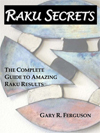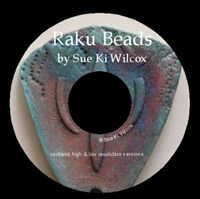|
- Article - Site Navigation Home Raku Artist Bio Raku Gallery Free Raku Glazes Raku Define Raku Links Raku Articles Raku Books |
Makinig Raku Wall Shard ArtMaking Shard Art "Did that piece break?" I sometimes get asked this question
when someone sees my Shard Art, which are platters that look as if they
have been broken into pieces and then stuck back together. Examples can be
seen at: http://www.garyrferguson.com/gallery2.htm When I first starting making them I actually used small slab sections about ¼ inch thick draped over a shallow platter about 12 to 15 inches across. I then used wads of clay to connect the two pieces by press it in from the back and paddling it smooth. I liked the look of this from the front, but the firing survival rate was not very high. What I believe was happening was the area between the slab and the wad of clay was very weak because the wad was being pushed level with the back of the slab which gave very little overlapping clay between the wad and the slab section. I liked the look of the affect from the front so I came up with a different technique. Now I throw out a slab the full size of the platter. I take a wooden knife and draw the shard pattern on the slab. I also draw in the sections that look like wads from the back to hold the slab sections together. I then use a fettling knife to carve out the sections that would be open if just using slabs and wads. So I am left with a single slab that has been carved to look as if it was made up of small random slabs and wads of clay connecting them. I then take this single carved slab and drape it face down over a shallow plastic plate or bowl and let it dry. I have to dry these very carefully as they love to develop cracks at any of the various cut out corners. To help alleviate this, I take the backside (not sharp) of the wooden knife and press it into each corner of a cut out to kind of smooth the corner a little. I think this makes it a little harder for a stress crack to start. I bisque them lying flat on a sprinkle of sand and Raku fire them on end. You have to be careful when you remove the piece from the kiln that you don't put excess stress on the piece by twisting the piece in the air with the tongs. Just let the piece hang straight down as much as possible. I don't create anything on the back of the piece for a wire or nail. I just drive a small nail in the wall (sometimes painted black) and then hang the piece from one of the holes created by the carving the slab. I really like the effect of these pieces. They are very different and exciting to look at. |
||
|
Books
Learn Dozens of Hints, Tips and Techniques in the free monthly newsletter Just
Raku Privacy Policy - Your email address or other personal information will only be used for this newsletter. It will never be given, rented, or sold to any other party for any other purposed. |
||
|
Gary R. Ferguson - Raku Artist (c) Copyright 2005, Gary R. Ferguson |
||




